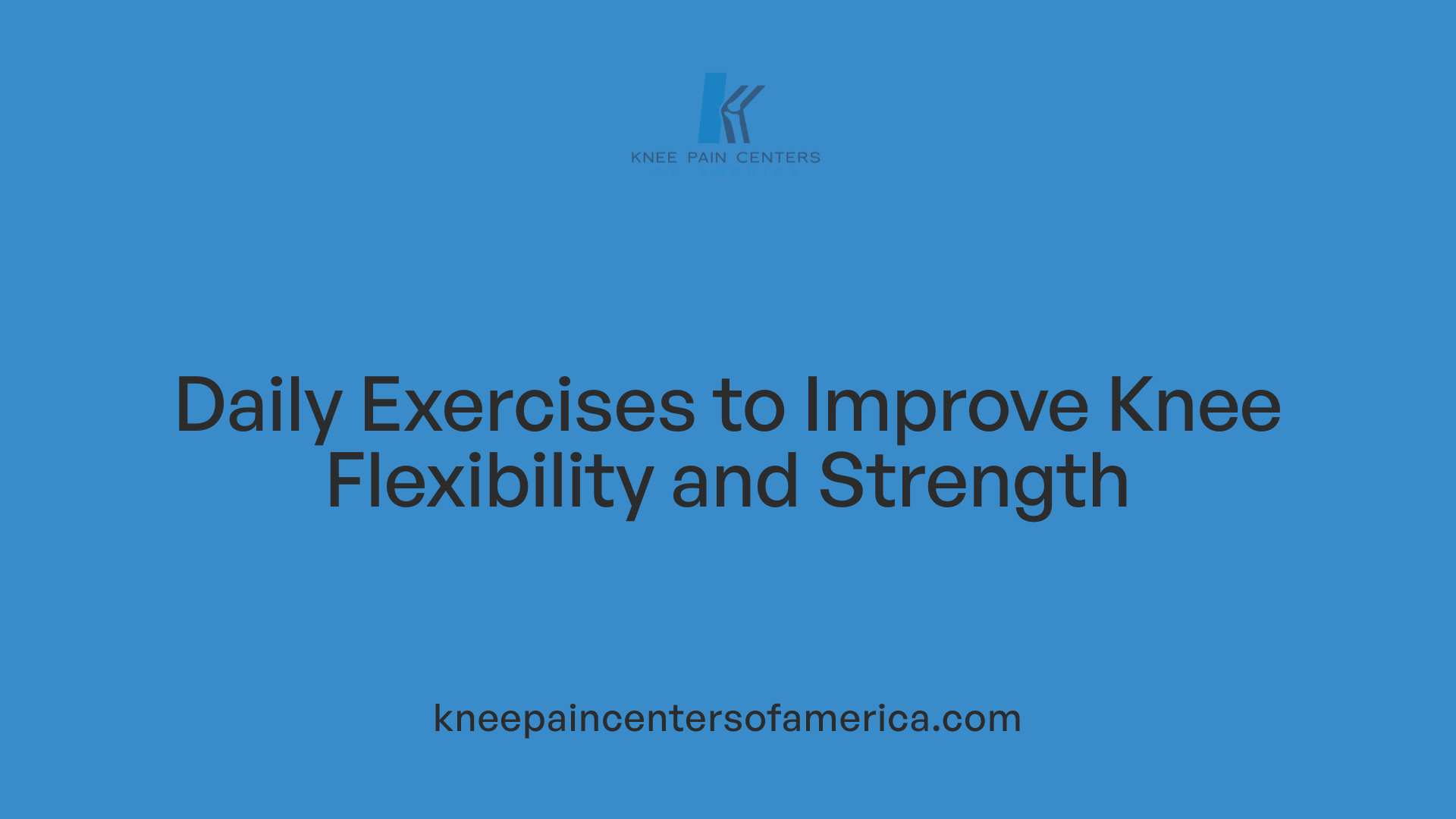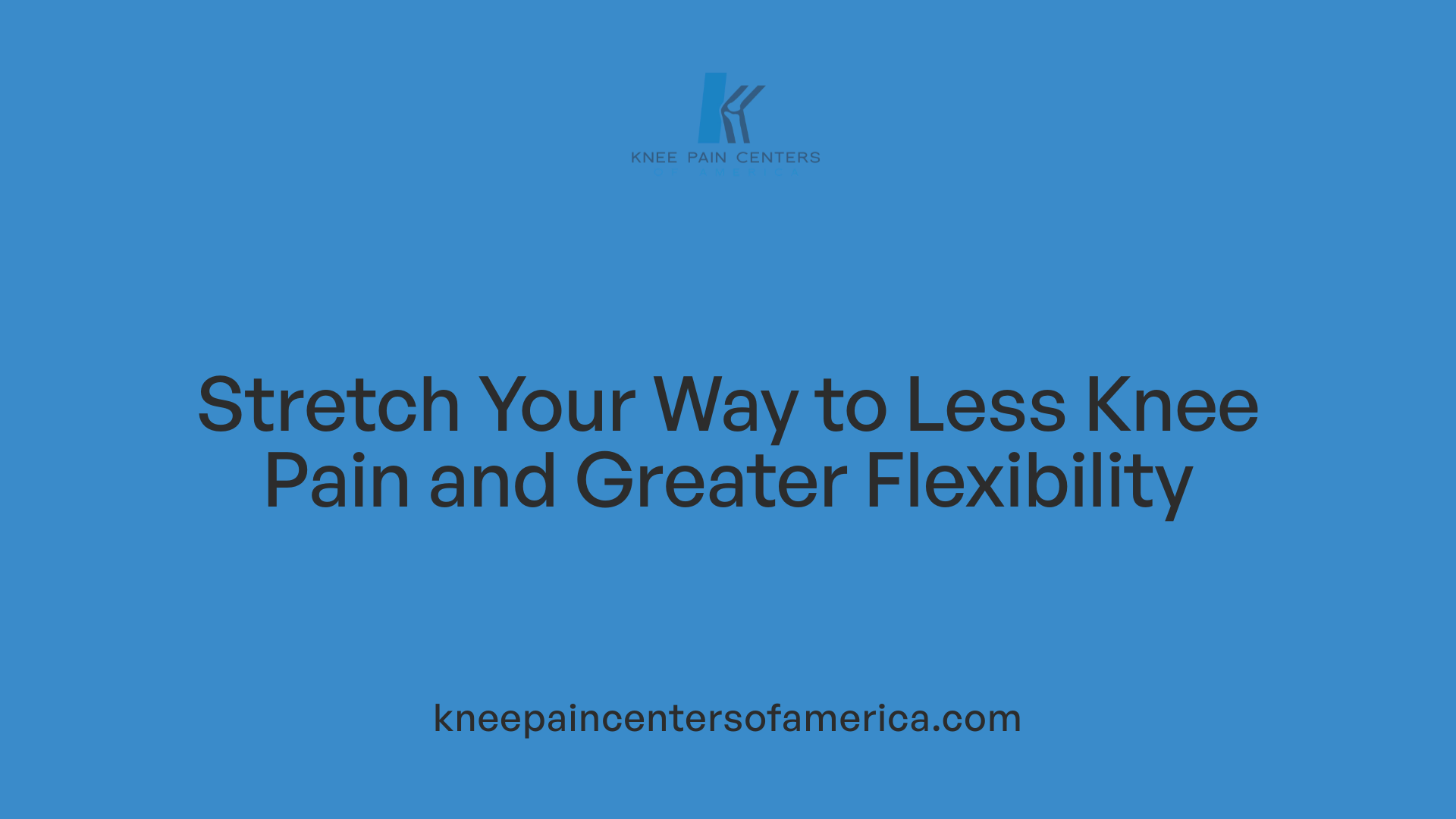Why Gentle Movements Matter for Knee Health
Knee pain and osteoarthritis affect millions worldwide, often limiting daily activities and mobility. While medical treatments play a crucial role, the importance of gentle, consistent daily movements and exercises cannot be overstated. These activities improve flexibility, reduce stiffness, and support joint health, ultimately enhancing quality of life. This article explores how incorporating gentle daily movements can encourage flexibility, reduce pain, and complement medical treatments for knee osteoarthritis.
Understanding Knee Osteoarthritis and Its Impact on Movement
What is Knee Osteoarthritis?
Knee osteoarthritis is a common joint condition where the cartilage cushioning the knee bones gradually wears away. This causes bones to rub against each other, leading to pain, swelling, and reduced mobility.
How Does Osteoarthritis Affect Knee Joints and Movement?
As osteoarthritis progresses, stiffness and joint inflammation increase. The loss of cartilage causes discomfort when bending or walking. Also, muscles around the knee may weaken due to pain and less frequent use, making stability and movement more difficult.
Common Symptoms and Challenges Experienced
Patients often face knee pain that worsens with activity, joint stiffness, and difficulty performing everyday tasks like standing, climbing stairs, or walking. This can impact overall quality of life, as mobility becomes limited and discomfort persists.
Understanding these effects highlights why gentle, regular exercise and stretching are vital to improve strength, flexibility, and reduce pain in knee osteoarthritis.
The Power of Gentle Exercise in Knee Pain Management

How do physical therapy and exercise contribute to managing osteoarthritis and knee pain?
Physical therapy and exercise are essential in managing osteoarthritis and knee pain by focusing on strengthening muscles around the knee. This reinforcement reduces stress on the joint and can slow the deterioration of cartilage. Exercise also improves joint flexibility, range of motion, and stability, which helps decrease pain and enhance mobility.
Specific exercises such as lying knee bends, static quadriceps strengthening, leg raises, sit-to-stand movements, and step-ups are recommended. These activities build strength gradually and should be performed regularly throughout the day, increasing repetitions and sets over time to support muscle conditioning. It is important to start exercises gently and avoid those that increase discomfort beyond acceptable levels.
Benefits of strengthening muscles around the knee
Strengthening muscles surrounding the knee provides robust joint support, potentially easing pain and reducing joint discomfort. Muscle strengthening activities, including resistance training and moderate-intensity low-impact cardiovascular workouts, help lubricate the joint and reduce stiffness. This also lowers systemic inflammation linked to joint pain.
Coupling strengthening with stretching exercises—such as hamstring, calf, quadriceps, and iliotibial (IT) band stretches—enhances knee stability by improving muscle flexibility and blood flow. Stretching helps loosen tight muscles and can prevent stiffness and discomfort commonly associated with osteoarthritis.
Improving joint flexibility and stability through exercise
Gentle stretching exercises are vital for improving knee joint flexibility and overall mobility. Holding stretches for 20-30 seconds, repeating 2 to 3 times, and gradually increasing hold times, improves range of motion and reduces tension around the knee.
Such exercises promote joint lubrication, reduce fluid accumulation, and release endorphins that act as natural painkillers. When combined with strengthening exercises like leg lifts and wall sits, stretching enhances knee support and helps maintain long-term joint health.
Consistently engaging in gentle exercise and stretching routines, alongside warming up and listening to pain cues, safeguards against injury and fosters better quality of life by maintaining knee function and reducing the need for medications or surgical interventions.
Gentle Daily Exercises to Enhance Knee Flexibility and Strength

What Are Recommended Gentle Exercises for Knee Osteoarthritis?
For managing knee osteoarthritis, a variety of gentle exercises can help improve movement and strengthen the affected knee. These include lying knee bends, static quadriceps strengthening, supported leg raises, bridging, sit-to-stand movements, step-up exercises, single-leg stands, backward lunges, and knee bends. Additionally, stretches targeting muscles like the hamstrings, calves, quadriceps, and iliotibial (IT) band play an important role in improving knee joint flexibility and reducing pain.
How Should Exercises Be Performed Gradually and Safely?
It's crucial to start these exercises gradually, paying close attention to pain levels. Exercises should be avoided if they increase discomfort beyond acceptable limits. Warming up beforehand and beginning with low-intensity movements can help avoid injury. Proper technique, such as avoiding bouncing during stretches and opting for low-impact activities, enhances safety and effectiveness. Exercises should be stopped immediately if symptoms worsen or new pain develops, with consultation from a healthcare professional if pain persists.
Why Is Regular Repetition and Progression Important?
Performing repetitions regularly throughout the day supports consistent strength building. Patients should aim to gradually increase both the number of repetitions and sets over time to build knee strength effectively. Stretching holds should start with short durations, such as 15-20 seconds, gradually increasing to 30 seconds to improve range of movement. Regular stretching and strengthening together support joint flexibility, improve blood flow, reduce stiffness, and help manage chronic knee pain often experienced with osteoarthritis.
Stretching Exercises: Unlocking Flexibility and Reducing Pain

Types of effective knee stretches
Several stretching exercises can significantly aid in improving knee flexibility and easing pain, especially for those with osteoarthritis. Key stretches include:
- Hamstring stretches (seated and standing)
- Calf stretches (wall calf and heel stretches)
- Quadriceps stretches
- Iliotibial (IT) band stretches
- Knee-to-chest stretches
- Butterfly stretches
- Seated leg extension stretches
These stretches focus on muscles around the knee such as hamstrings, calves, quadriceps, and the IT band, which are crucial for knee stability and mobility.
How stretching improves muscle flexibility and joint range of motion
Regular stretching helps loosen tight muscles surrounding the knee, reducing stiffness and discomfort. Stretching also promotes better blood flow, which can decrease fluid buildup in the joint and supports overall knee health. By moving joints through their full range of motion, stretching aids in preventing pain and stiffness associated with knee osteoarthritis.
In addition, stretching encourages the release of endorphins, natural painkillers that aid in pain management. This combination enhances mobility and alleviates chronic knee pain, supporting long-term joint health.
Recommended duration and technique for stretching
To gain maximum benefits, each stretch should be held for 20 to 30 seconds. Starting with shorter holds and gradually increasing duration helps prevent injury and allows the muscles to adapt. Repeating each stretch 2 to 3 times daily is advisable.
Proper technique is essential: warming up before stretches, avoiding bouncing movements, and performing stretches gently help ensure safety and effectiveness. Pairing stretching with strengthening exercises like leg lifts can further improve knee support. Consistency in stretching fosters improved flexibility, reduces stiffness, and enhances overall knee function.
Incorporating Stretching into Daily Routine for Long-Term Joint Health
What Are the Benefits of Daily Stretching for Knee Joint Health?
Daily stretching exercises provide significant benefits for knee joint health, especially for those dealing with osteoarthritis. Regular stretches enhance flexibility in the muscles around the knee—such as the hamstrings, calves, quadriceps, and iliotibial (IT) band—which are crucial for stabilizing the joint and maintaining mobility. This increased flexibility can reduce tension and pressure on the knee, helping to alleviate discomfort and support overall joint function.
How Does Stretching Help Reduce Stiffness and Improve Blood Flow?
Stretching exercises help loosen tight muscles surrounding the knee, which can reduce stiffness commonly associated with joint conditions. By promoting greater muscle relaxation, stretching increases blood circulation to the joint area. This improved blood flow aids in reducing fluid accumulation and supplies essential nutrients, contributing to better joint lubrication. Enhanced lubrication reduces friction and encourages smoother knee movements, which may decrease pain and stiffness.
How Can Stretching Support Chronic Pain Management?
Including knee-specific stretches in a daily routine can play an important role in managing chronic knee pain. Stretching not only relieves tension but also triggers the release of endorphins, the body's natural painkillers, which help reduce pain perception. When combined with strengthening exercises like leg lifts and wall sits, stretching supports knee stability and function, potentially minimizing joint pain over time. Consistency in stretching can contribute to long-term improvements in mobility and decreased discomfort, offering individuals with chronic knee conditions a practical self-care strategy.
Medical Interventions for Knee Pain: When Are They Needed?
What are the most effective medical treatments available for managing knee pain and osteoarthritis?
Managing knee pain and osteoarthritis effectively involves a range of medical treatments tailored to the severity of the condition and patient needs. Common options include nonsteroidal anti-inflammatory drugs (NSAIDs) to reduce pain and inflammation. Physical therapy plays a crucial role in improving joint mobility and strengthening surrounding muscles. Injections of corticosteroids or hyaluronic acid are used to decrease inflammation and provide temporary pain relief.
Recently, minimally invasive procedures such as genicular artery embolization (GAE), also known as knee embolization, have gained attention. This outpatient procedure targets abnormal blood flow linked to inflammation by blocking specific blood vessels. Many patients report significant and lasting pain relief within weeks to months after GAE, making it a viable alternative for those not suited for surgery or wishing to avoid it. Emerging studies suggest that beyond symptom relief, GAE may help slow osteoarthritis progression by reducing inflammatory markers.
When is surgical intervention considered for patients with knee osteoarthritis?
Surgery, including partial or total knee replacement, is typically considered when conservative treatments fail to provide sufficient pain relief and the disease severely impacts daily life. Signs warranting surgical evaluation include persistent severe pain, swelling, and difficulty with routine activities such as climbing stairs or walking.
Imaging, usually through standing X-rays, helps confirm the extent of cartilage damage. Partial knee replacement may be suitable if only one compartment of the knee is involved. In contrast, total knee replacement—resurfacing all three compartments—is generally required for more extensive damage. Surgical goals focus on alleviating pain, restoring function, and improving the patient's mobility and quality of life.
What is the role of healthcare professionals in treatment planning?
Healthcare professionals play a vital role in devising personalized treatment plans. They assess the disease severity, evaluate symptoms, and consider overall patient health and preferences. Through careful monitoring and reassessment, they guide patients through the spectrum of interventions—from medication and physical therapy to injections and advanced minimally invasive techniques or surgery—ensuring optimal outcomes tailored to each individual.
Dealing with knee osteoarthritis requires an integrated approach where medical treatments complement physical exercises and lifestyle adaptations, with healthcare providers coordinating comprehensive care to enhance joint health and patient well-being.
Injections in Knee Osteoarthritis: Corticosteroids and Hyaluronic Acid
What role do corticosteroid and hyaluronic acid injections play in treating knee osteoarthritis?
Corticosteroid injections are commonly used in knee osteoarthritis to provide rapid, short-term pain relief by reducing joint inflammation. Their effects typically last up to one month, making them effective for managing flare-ups and acute discomfort. These injections help decrease swelling and improve knee function temporarily.
Hyaluronic acid injections, sometimes called viscosupplementation, aim to restore the natural lubrication of the osteoarthritic joint. Unlike corticosteroids, their benefits develop more gradually, often becoming noticeable around six months after treatment. This increased joint lubrication helps reduce friction during movement, potentially leading to less pain and improved mobility over the longer term.
Comparing short-term and long-term relief
| Injection Type |
Primary Effect |
Duration of Relief |
Additional Benefits |
Common Side Effects |
| Corticosteroids |
Reduce inflammation |
Up to 1 month |
Quick pain relief, improved range of motion |
Generally well tolerated, minor local reactions |
| Hyaluronic Acid |
Lubricate joint, restore viscosity |
Up to 6 months or longer |
Sustained pain relief, better joint lubrication |
More topical adverse effects possible |
Both injections can improve knee function and flexibility, but corticosteroids are preferred for immediate symptom control, especially in acute episodes. Hyaluronic acid is more suitable for patients seeking longer-term relief with an emphasis on joint health.
Safety and use considerations
Both corticosteroid and hyaluronic acid injections are generally safe when administered appropriately. Patients should consult healthcare professionals to determine the best option based on symptom severity, treatment goals, and individual tolerance. These injections are typically recommended when conservative measures—like exercise, physiotherapy, and weight management—do not sufficiently alleviate symptoms.
Emerging Treatments and Medical Advances for Osteoarthritis Care

Are there any emerging treatments or medical advances for knee pain and osteoarthritis being researched?
Recent advances in osteoarthritis care are expanding beyond traditional approaches, offering hope to those suffering from knee pain. One promising minimally invasive procedure is genicular artery embolization, which works by reducing blood flow to the synovium—the knee's lining that becomes inflamed in osteoarthritis. Clinical studies show that over 60% of patients undergoing this treatment experience significant pain relief and improved function.
Alongside this, gene therapy is undergoing active research. Scientists are exploring techniques to modify joint cells genetically so they produce anti-inflammatory proteins, such as interleukin-1 receptor antagonist (IL-1Ra). Early clinical trials have reported sustained reductions in pain with no major safety concerns, marking gene therapy as a potential game-changer for managing osteoarthritis at a molecular level.
Biologic therapies are also advancing, including platelet-rich plasma (PRP) injections, stem cell treatments, and novel biologics. These aim to promote cartilage repair and regulate joint inflammation. Although evidence on long-term effectiveness is still emerging, these approaches represent an exciting frontier that could supplement or reduce the need for surgery.
Researchers are additionally focusing on personalized medicine by harnessing genetic insights to develop targeted pharmacologic treatments. Such innovations promise to tailor therapies specifically to an individual’s disease profile, optimizing outcomes.
Together, these emerging treatments offer new avenues for those who may not be candidates for conventional surgical interventions, highlighting a future where osteoarthritis management becomes more precise and effective.
Integrating Gentle Movements and Medical Treatments for Optimal Outcomes
How can exercise be combined with injections and other therapies for knee osteoarthritis?
Combining regular gentle exercises with medical treatments such as injections can significantly enhance knee osteoarthritis management. Exercises like knee bends, leg lifts, and stretches improve joint mobility and muscle strength, making the knee more resilient. Meanwhile, treatments including corticosteroid or hyaluronic acid injections can reduce inflammation and provide pain relief. When coordinated properly, this integrated approach supports both symptom relief and functional improvement.
Why is monitoring pain and adjusting activity levels important?
Starting exercises gradually while listening to your body's signals is essential to avoid aggravating the knee joint. If an exercise causes pain beyond a tolerable level or new discomfort, it's important to stop and adjust the activity. Gradual progression with increased repetitions and duration helps build strength without overloading the joint. This careful balance ensures that exercise remains beneficial rather than harmful.
How can collaboration with healthcare providers personalize knee osteoarthritis care plans?
Working closely with healthcare providers allows for the creation of tailored exercise and treatment plans that address individual needs and limitations. Professionals can recommend appropriate low-impact activities and advise on when to utilize injections or other therapies. Ongoing monitoring helps modify the plan based on symptom changes or treatment responses, ensuring the most effective and safe approach for long-term knee health.
Practical Tips for Safe and Effective Daily Knee Exercises

Warming up adequately before exercise
Warming up is essential to prepare your knee joints and muscles for movement. Begin with gentle, low-intensity activities such as slow walking or cycling for 5 to 10 minutes. This helps increase blood flow, lubricate the joints, and reduce the risk of injury. Avoid jumping into intense exercise without properly warming up.
Starting with low-intensity, low-impact activities
For knee health, opt for exercises that are gentle on the joints. Low-impact activities like swimming, cycling, and walking provide cardiovascular benefits without placing excessive stress on the knees. Begin gradually with lower intensity and duration, and slowly increase as your strength and comfort improve.
Listening to pain signals and avoiding exacerbation
It is crucial to pay close attention to any knee pain during exercise. While some mild discomfort may be normal when building strength, avoid exercises that increase pain beyond an acceptable level. If pain worsens or new pain arises, stop the activity and consult a healthcare professional to prevent joint damage.
Use of supportive footwear and hydration
Wearing supportive, well-cushioned footwear helps absorb shock, enhance stability, and reduce strain on the knee. Proper shoes can make exercises like walking or step-ups more comfortable and safer. Additionally, staying hydrated supports joint lubrication and overall health, making it easier to maintain consistent exercise routines.
By integrating these safety strategies into your daily knee exercise routine, you can achieve improved strength, flexibility, and mobility while protecting your joints from injury and overuse.
Embracing Movement for Lasting Knee Health
Gentle daily movements, including stretching and strengthening exercises, serve as essential tools in encouraging flexibility, reducing pain, and supporting overall knee health in individuals with osteoarthritis. When paired with appropriate medical treatments—ranging from conservative therapies to innovative minimally invasive procedures—these movements can help maintain mobility, enhance quality of life, and potentially delay the need for surgery. Patients are encouraged to engage in regular, mindful exercise routines, paying close attention to their bodies and collaborating closely with healthcare professionals to tailor interventions. By embracing gentle movement daily, individuals can take proactive steps toward managing knee osteoarthritis and preserving joint function for the long term.
References